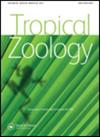尺寸重要吗?巴西蝙蝠的多样性和岩石避难所的使用
IF 0.7
4区 生物学
Q4 ZOOLOGY
引用次数: 0
摘要
一些作者记录了南美洲不同洞穴地区洞穴大小与蝙蝠多样性之间的正相关关系。我们分析了来自三个巴西喀斯特地区和植物地理学领域的已发表和其他可用数据,包括东北和东南大西洋森林和塞拉多(稀树草原状植被),包括各种洞穴大小。根据研究人员和洞穴学家先前的观察结果,我们没有发现这种相关性。我们讨论了测量蝙蝠多样性的不同方法的生态影响,即物种的累积数量(洞穴的顺序使用)与特定场合的物种数量(实际同居的物种)与蝙蝠的丰度(个体数量),以及与洞穴概念相关的洞穴学主题(基于拟人化定义,不适用于其他物种)、估计洞穴面积和体积等地形变量的问题,以及在分析中包括洞穴温度的价值。多种相互作用的变量可能会影响洞穴蝙蝠群落的组成以及蝙蝠物种的丰富度和丰度。最重要的因素是给定区域的洞穴密度(与岩性有关——钙质洞穴与硅质碎屑洞穴)、区域气候和表观栖息地的保护程度。洞穴形态、入口的数量和大小、水体的存在以及与其他物种的相互作用也必须考虑在内。总之,作为热带和亚热带蝙蝠的一般说法,洞穴大小(在人类意义上)本身并不重要,也许除了一次性的情况。最后,简要介绍了巴西洞穴蝙蝠的多样性。本文章由计算机程序翻译,如有差异,请以英文原文为准。
Does size matter? Bat diversity and the use of rock shelters in Brazil
A positive correlation between cave size and bat diversity has been recorded by some authors for different cave areas in South America. We analyzed published and otherwise available data from three Brazilian karst areas and phytogeography domains, including NE and SE Atlantic Forest and Cerrado (savannah-like vegetation), encompassing a wide range of cave sizes. We found no such correlation, as expected in view of previous observations by researchers and speleologists. We discuss the ecological implications of different ways to measure bat diversity, i.e. the accumulative number of species (sequential use of caves) vs. the number of species at a given occasion (species in actual cohabitation) vs. bat abundance (numbers of individuals), as well as speleological topics related to the concept of caves (based on an anthropomorphic definition, not applicable to other species), the problems of estimating topographic variables such as cave area and volume, and the value of including cave temperatures in the analyses. Multiple interacting variables may influence the composition of cave bat communities and bat species richness and abundance. The most important ones would be the density of caves in a given area (related to lithology – calcareous vs. siliciclastic caves), regional climates, and degree of preservation of epigean habitat. Cave morphology, number and size of entrances, and presence of water bodies, as well as interactions with other species, must also be considered. In conclusion, as a general statement for tropical and subtropical bats, cave size (in the human sense) by itself does not matter, except perhaps for one-off situations. Finally, a brief overview of the diversity of cave bats in Brazil is presented.
求助全文
通过发布文献求助,成功后即可免费获取论文全文。
去求助
来源期刊

Tropical Zoology
生物-动物学
CiteScore
2.50
自引率
0.00%
发文量
1
审稿时长
>12 weeks
期刊介绍:
Tropical Zoology is an international zoological journal publishing original papers in the field of systematics, biogeography, phylogeny, ecology and conservation of all terrestrial and aquatic animal Phyla from tropical and subtropical areas.
Only papers with new information, high quality and broad interest are considered. Single species description and checklists are not normally accepted. Review papers are welcome. The journal is owned by the Istituto di Ricerca sugli Ecosistemi Terrestri of the Consiglio Nazionale delle Ricerche, Florence, Italy (CNR-IRET) who performs research into the structure and functioning of aquatic and terrestrial ecosystems, focusing in particular on anthropogenic pressure and global change. The knowledge amassed forms the scientific basis for identifying the most appropriate protective and corrective interventions, and provides support for the bodies entrusted with formulating policies for environmental protection and recovery.
 求助内容:
求助内容: 应助结果提醒方式:
应助结果提醒方式:


